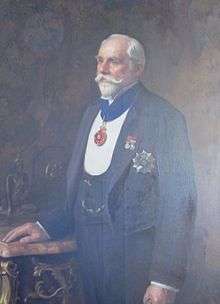Guilford Lindsey Molesworth
| Sir Guilford Lindsey Molesworth | |
|---|---|
 | |
| Born | 1828 |
| Died | 1925 |
| Nationality | English |
| Occupation | Engineer |
| Engineering career | |
| Discipline | Civil, |
| Institutions | Institution of Civil Engineers (president), |
| Projects | Royal Arsenal, Woolwich |
Sir Guilford Lindsey Molesworth KCIE (1828–1925) was an English civil engineer.
Biography
Early years
Molesworth was born in Millbrook, Hampshire and was the son of John Edward Nassau Molesworth, Vicar of Rochdale who was the great grandson of Robert Molesworth, 1st Viscount Molesworth.[1] Sir Guildford's great niece was Margaret Patricia Molesworth (1904–1985), the grandmother of Sophie, Countess of Wessex.[2][3] Molesworth was educated at the College for Civil Engineers at Putney, apprenticed under Mr Dockray in the London and North Western Railway, and under Sir William Fairbairn at Manchester.
Career
He became a chief assistant engineer of the London, Brighton and South Coast Railway, but soon resigned to conduct the constructions at the Royal Arsenal, Woolwich, during the Crimean War. He received the Watt Medal and the Manby premium in 1858 from the Institution of Civil Engineers for his paper on Conversion of Wood by Machinery. He returned to London for a number of years, worked at his profession, then went to Ceylon in 1859 and in 1862 became chief engineer of the government railways in Ceylon. From 1871 to 1889 he was consulting engineer to the Indian government with regard to State railways. He received medals from the British Government for his services during the Afghan War and the Burma War, and was president of the Institution of Civil Engineers in 1904.[4][5]
Gauge
Molesworth was consulted on a number of occasions on the suitability of adopting a narrow gauge rather than a broad one. He was generally against the narrow gauge as he regarded the cost savings as illusory. His broad gauge line to Kandy is proof that this gauge is practicable in steep mountains.
Bibliography
He published a Pocketbook of Engineering Formulae (twenty-seventh edition, 1914). His works include:
- State Railways in India (1872)
- Metrical Tables (1880; fourth edition, 1909)
- Imperialism in India (1885)
- Silver and Gold (1891)
- Our Empire under Protection and Free Trade (1902)
- Economic and Fiscal Facts and Fallacies (1909)
- Indian Railway Policy (1920)
References
- ↑ Beeching, H. C. "Dictionary of National Biography, 1885-1900, Volume 38 - (Rev.) Molesworth, John Edward Nassau". Dictionary of National Biography. Retrieved 6 October 2017.
- ↑ Burke's Peerage, Baronetage & Knightage, 107th edition, volume 2, 2003. pages 2721–2731.
- ↑ "Molesworth History". moleswoth.id.au. Retrieved 6 October 2017.
In 1999, when I (the Right Honourable the (12th) Viscount Robert Molesworth) had the honour to be invited to Windsor Castle to represent the family at the marriage of Prince Edward to Sophie Rhys-Jones (whose paternal grandmother was Margaret Patricia Molesworth)....
- ↑ Watson, Garth (1988), The Civils, London: Thomas Telford Ltd, p. 252, ISBN 0-7277-0392-7
- ↑ Anon. (1887). "Guilford L. Molesworth". Indian Engineering: 222.
External links
- "A GREAT ENGINEER". The Sydney Morning Herald. National Library of Australia. 17 June 1922. p. 8. Retrieved 13 July 2012.
| Professional and academic associations | ||
|---|---|---|
| Preceded by William Henry White |
President of the Institution of Civil Engineers November 1904 – November 1905 |
Succeeded by Alexander Binnie |